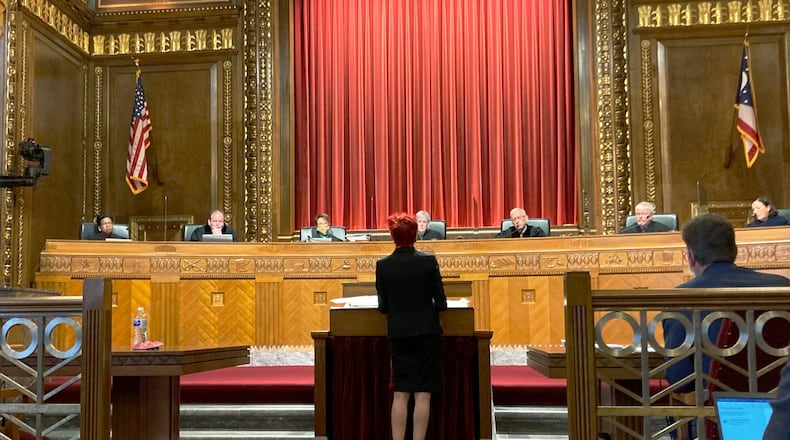The court ruled 4-3 that the district map is unconstitutionally gerrymandered to favor the Republican Party. Chief Justice Maureen O’Connor, whose term ends this year, joined the court’s three Democrats in rejecting the map. The decision came in Neiman et al. v. LaRose et al. Other plaintiffs are involved in related litigation, including the League of Women Voters of Ohio.
In accordance with 2020 census results, Ohio must reduce its U.S. House seats from 16 to 15. Currently Ohio is represented by 12 Republicans and four Democrats. In November legislators passed a new U.S. House map, but voting-rights and progressive groups filed suit.
“The General Assembly shall pass a new congressional-district plan that complies with the Ohio Constitution within 30 days,” the majority opinion says. “If the General Assembly fails to do so, the Ohio Redistricting Commission (will be required) to adopt a constitutional plan within the following 30 days.”
The Ohio Supreme Court threw out that map on Jan. 14 as unfairly favoring Republicans and told the General Assembly to try again. The General Assembly took no action, however, sending the job back to the Ohio Redistricting Commission.
The commission passed another map March 2 by a 5-2 vote supported by all five Republican commission members and opposed by the body’s two Democrats. Democrats said they were frozen out of the map-drawing process until shortly before the final vote.
Opponents of the previous map renewed their objections, but the March 2 map was used for the May 3 partisan primary and so remains in place for the Nov. 8 general election.
In their response to the renewed litigation, Ohio Senate President Matt Huffman, R-Lima, and House Speaker Bob Cupp, R-Lima, asked to use the March 2 map for the 2022 election cycle and hold any further action until later. Cupp and Huffman were members of the redistricting commission until early May, when they were replaced by state Rep. Jeff LaRe, R-Violet Twp., and state Sen. Rob McColley, R-Napoleon, respectively.
Several of the U.S. House districts singled out as unfair are in or adjacent to the Miami Valley.
The March 2 map divides Hamilton County diagonally, with the southeast portion in District 1 and the rest as part of District 8, which also includes Butler, Darke, Preble and part of Miami County.
District 10 covers Montgomery, Greene, and south-central Clark County.
District 15 includes the remainder of Clark County, eastern Miami County and parts or all of Shelby, Madison, Franklin and Fayette counties.
In its objections to the March 2 map, the League of Women Voters of Ohio specifically sought redrawing of Districts 1 and 15.
The court decision notes objections made by House Minority Leader Allison Russo, D-Upper Arlington, to the March 2 map. Russo, a member of the redistricting commission, pointed out that the Republican-drawn plan split urban and minority populations around Cincinnati, Cleveland and Columbus, diluting Democratic votes.
The now-overturned map would ostensibly create 10 Republican-leaning and five Democratic-leaning seats. But three of the Democratic-leaning seats only do so by less than 5%, while none of the Republican-leaning districts do so by less than 6.64%, according to the breakdown mapmakers distributed.
The map rejected by justices in January would’ve given 80% of the House seats to Republicans, despite the party receiving only slightly more than half of votes statewide, according to Tuesday’s ruling.
The March 2 map is “only slightly less favorable to the Republican Party,” and three of the five Democratic-leaning districts do so by slim margins, the ruling says.
“Jonathan Rodden, a professor of political science at Stanford University with expertise in the analysis of fine-grained geospatial data sets, including election results, predicts that it is most likely that Democrats will win four seats — only a one-seat improvement from the original plan. Senate President Huffman and House Speaker Cupp do not dispute these projections,” the court’s opinion says.
The court relied on several analyses from statistical experts to say it’s overwhelmingly likely that districts were carefully drawn to disadvantage Democrats. The majority cited Rodden’s assertion that the March 2 plan also favors Republican incumbents.
“Of 12 Republican incumbents, ten are in safe Republican-leaning districts, one is in a nominally Democratic-leaning district that retains about 70 percent of the population of his previous district, and one did not seek reelection,” the ruling says. “By contrast, of the four Democratic incumbents, two are in safe Democratic-leaning districts, one is in a district with a bare Democratic majority with only about half of the residents of the new district having been residents of her previous district, and one did not seek reelection.”
A map passed with single-party support, even if upheld by the court, must be redrawn in four years. A map supported by both parties would be valid until the election after the next U.S. census in 2030.
About the Author

